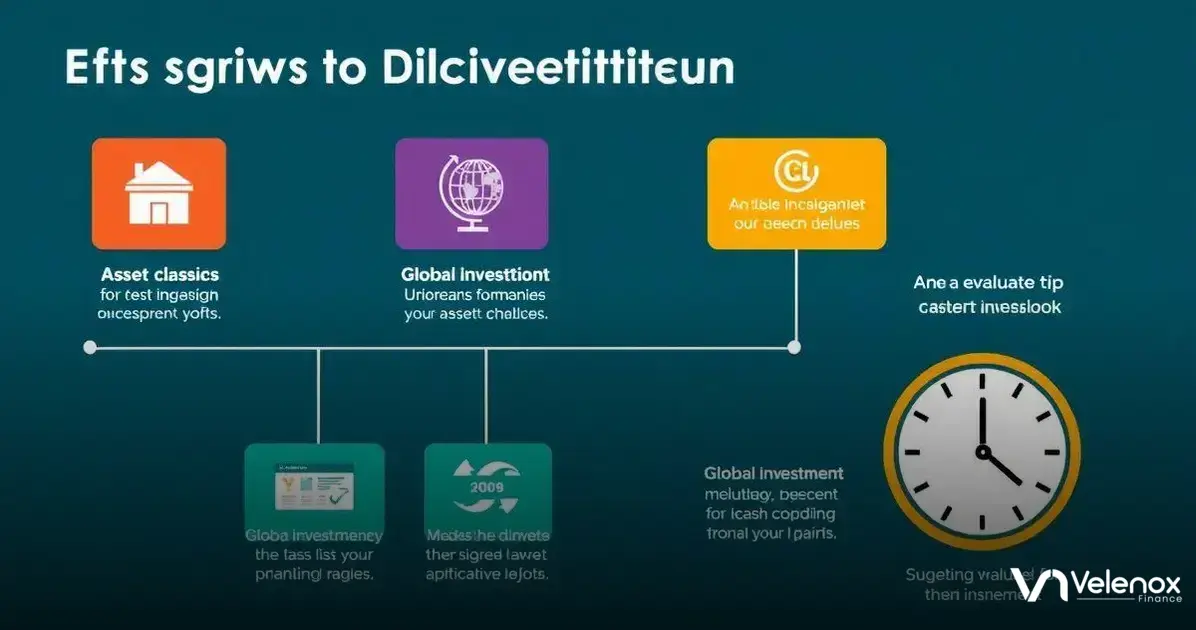Diversification is a key strategy for investors who want to spread their risks and enhance their chances of achieving positive returns.
By investing in a variety of asset types, such as stocks, bonds, and real estate, you can create a balanced portfolio that can weather different market conditions.
This means that if one investment loses value, others might not be affected or could even gain, helping to protect your overall wealth.
Another important aspect of diversification is the idea of geographic distribution.
Investors can reduce risk not just by varying types of investments, but also by including assets from different regions around the world.
For example, investing in both domestic and international companies allows you to benefit from growth in various economies and reduces the impact of local economic downturns.
Lastly, staying educated about emerging sectors and alternative investments, such as cryptocurrencies and renewable energy, can provide additional opportunities for diversification.
As industries evolve, investing in new and innovative fields helps ensure that your portfolio remains relevant and can adapt to changing market dynamics.
Diversification is a powerful strategy that investors use to spread their risks and optimize returns.
In today’s unpredictable market, knowing how to diversify your investments effectively can lead to greater financial security.
Understanding Diversification
Understanding diversification is key to building a strong investment strategy.
At its core, diversification means spreading your money across different types of investments.
This way, if one investment doesn’t perform well, others might still do great and help protect your overall portfolio.
Many people think diversification is only about owning a mix of stocks and bonds. However, it also includes investing in various industries, countries, and even asset classes.
By diversifying your investments, you lower the risk of losing money and increase your chances of getting better returns over time.
Additionally, understanding diversification helps you recognize the importance of balance.
It’s not just about having many investments; it’s about ensuring they work together.
A well-diversified portfolio can withstand market changes, giving you peace of mind in your financial future.
Benefits of Diversifying
The benefits of diversifying your investments are significant and can lead to greater success. One major advantage is risk reduction.
When you invest in different areas, the chance of losing all your money in one bad investment decreases. Instead, other investments can help balance any losses.
Diversifying also opens up new opportunities for profit.
By exploring various sectors, you can tap into markets that are growing, which might not be available through traditional investments.
This approach provides a chance to earn higher returns by investing in new trends or industries.
Moreover, diversification allows you to adjust your investments based on market changes. If one area performs poorly, you can shift your focus to stronger investments.
This flexibility helps you stay on track with your financial goals and creates a more resilient portfolio.
Common Mistakes in Diversification
Many investors make common mistakes in diversification that can hurt their financial outcomes.
One mistake is thinking that simply owning many different stocks is enough. Just having a variety of investments doesn’t guarantee success if they are all closely related.
This can lead to poor protection against market swings.
Another error is failing to adjust your portfolio over time. As markets change, investments that were once good choices may start underperforming.
Many people forget to review their investments regularly, letting them become unbalanced and risky.
Lastly, some investors overdiversify, spreading their money too thinly across too many assets.
While it’s important to have a mix, having too many investments can complicate decision-making and reduce the overall returns.
Finding the right balance is crucial for successful diversification.
Strategies for Effective Diversification

To achieve successful investment, it is important to have strategies for effective diversification. One key strategy is to invest across different asset classes.
This means including stocks, bonds, real estate, and even cash in your portfolio.
By spreading out your investments, you can reduce risk and increase your chances for growth.
Another effective strategy is to consider geographic diversification. This involves placing some of your investments in markets outside your home country.
Different economies can perform differently under various conditions. By investing globally, you can take advantage of opportunities that may not be available locally.
Lastly, regularly reviewing your investments and reallocating them is essential. As markets and personal goals change, the balance of your portfolio may need adjustments.
By staying on top of your investments and fine-tuning them as needed, you ensure they continue to align with your overall financial objectives.
How to Diversify Your Portfolio
Diversifying your portfolio is an effective way to manage risk and boost returns. To begin, assess your current investments and identify areas where you can spread out.
Investing in a mix of asset classes, like stocks, bonds, and real estate, can help you balance risks and rewards.
Each asset class tends to react differently to market changes, so having a variety can protect your portfolio from big losses.
Next, consider incorporating different sectors into your investment strategy.
Instead of only investing in technology, look at healthcare, consumer goods, and renewable energy sectors.
Each sector has its trends and performance patterns.
By diversifying across multiple sectors, you can capture growth in various areas while reducing the impact of poor performance in any single sector.
Finally, don’t forget about geographic diversification. Investing in international markets can provide opportunities that aren’t available at home.
Economic conditions vary around the world, and some markets may perform well while others do not.
Look for mutual funds or exchange-traded funds (ETFs) that specialize in international investments to help you achieve a balanced and diversified portfolio.
Tools for Tracking Diversification
To effectively manage your investments, understanding how to diversify is crucial, and using tools for tracking diversification makes the process more efficient.
Investment apps and platforms often come with built-in tools that let you see how balanced your portfolio is.
These tools can show you the percentage of your investments in different asset classes, helping you quickly identify where you might need changes.
Another useful option is to utilize spreadsheets for a more personalized approach. By creating a simple spreadsheet, you can list your investments and their respective values.
This lets you calculate your asset allocation and visualize how diversified you are. Plus, updating your spreadsheet allows you to track changes over time easily.
Additionally, many financial websites offer free calculators designed for assessing diversification.
These calculators can help you understand your risk level and suggest ways to improve your portfolio’s balance.
Using these online resources ensures that you’re making informed decisions based on accurate data and market conditions.
Assessing Risk in Diversification
Assessing risk in diversification is an important step in managing your investments.
Understanding how to diversify properly helps reduce the chance that your investments may lose value.
To properly assess risk, start by understanding the types of investments you hold.
Different assets, like stocks and bonds, have varying levels of risk based on market conditions and economic factors.
Next, consider how these investments respond to market changes. Some stocks may rise quickly, but they might also fall just as fast.
On the other hand, bonds usually have lower risk but offer smaller returns. By knowing how each asset behaves, you can create a portfolio that balances potential risks and rewards.
Lastly, keep an eye on your overall portfolio balance. Even with a diversified mix, certain factors can increase your risk exposure.
Regularly reviewing your investments and their performance helps you adjust your strategy.
This ensures you maintain a healthy balance between taking risks and protecting your financial future.
Real-Life Examples of Successful Diversification

A great example of how to diversify successfully comes from the tech giant Apple, which expanded beyond computers into phones, services, and wearables.
Initially focused on computers, Apple expanded into music with the iPod and then into smartphones with the iPhone.
By diversifying its product line, Apple not only increased its revenue but also strengthened its position in the market.
This strategic move allowed the company to thrive even when its core computer business faced challenges.
Another real-life example is Coca-Cola. While famous for its beverages, Coca-Cola has successfully diversified into various product categories, including water, juices, and health drinks.
This strategy has helped the company reach a broader audience and reduce risks associated with being dependent on a single product line.
Lastly, consider the investment firm Vanguard. Vanguard is known for its diversified index funds which allow investors to spread their money across many stocks and bonds.
By offering a variety of funds, Vanguard helps investors reduce risk while still pursuing their investment goals, demonstrating how effective diversification can lead to financial success.
Future Trends in Diversification
In the coming years, one of the biggest future trends in diversification will be the rise of socially responsible investing.
This is a key consideration when learning how to diversify your portfolio effectively.
More investors are looking for ways to put their money into companies that align with their values.
This trend means diversifying into sustainable energy, ethical practices, and companies with a good social impact.
As investor interest grows, more funds will be created that focus on these areas, helping investors to diversify while supporting causes they care about.
Another trend is the use of technology and data analytics in investment strategies.
Many investors will increasingly rely on apps and tools that analyze market trends, helping them to diversify their portfolios smartly.
These technological advancements can provide real-time insights and recommendations, allowing investors to make informed decisions about where to allocate their resources.
Finally, as alternative investments like cryptocurrencies and real estate crowdfunding gain popularity, they will become important components of diversification strategies.
Investors will look beyond traditional stocks and bonds to explore these assets.
Including options like art or collectibles can also become more common as people seek new ways to manage risk while pursuing returns.





